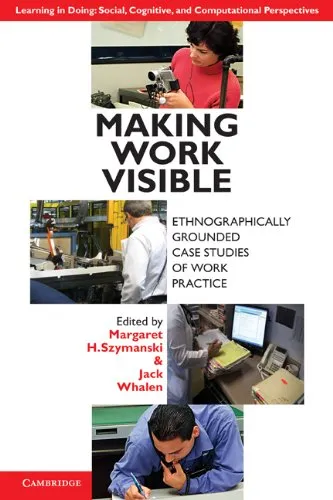Making Work Visible: Ethnographically Grounded Case Studies of Work Practice
4.0
Reviews from our users

You Can Ask your questions from this book's AI after Login
Each download or ask from book AI costs 2 points. To earn more free points, please visit the Points Guide Page and complete some valuable actions.Related Refrences:
Introduction to "Making Work Visible: Ethnographically Grounded Case Studies of Work Practice"
"Making Work Visible: Ethnographically Grounded Case Studies of Work Practice," edited by Margaret H. Szymanski and Jack Whalen, invites readers to explore the intricate, often unseen dynamics of work practices. Through a collection of ethnographic case studies, this book delves deep into how work unfolds in organizations, highlighting the interplay of sociocultural, technological, and organizational factors. By making these practices visible, the book fosters a nuanced understanding of the everyday work that drives productivity, collaboration, and innovation.
Detailed Summary of the Book
The core premise of "Making Work Visible" rests on the need to uncover and analyze the invisible structures of work—those activities and interactions that often go unnoticed but are essential to organizational functioning. As editors, Szymanski and Whalen bring together diverse ethnographic studies, each contributing unique insights into how work is executed, coordinated, and perceived in different contexts.
The chapters span a variety of industries, including healthcare, technology, and customer service. Through detailed observations and analyses, the contributors explore themes such as communication in the workplace, the role of tools and technologies, the coordination of team efforts, and the social norms guiding professional interactions. These case studies serve as a lens to examine broader concepts like accountability, adaptability, and innovation.
By taking an ethnographic approach, the book emphasizes the lived experiences of workers and the subtleties of their environments. Readers gain an insider’s perspective on how work is planned, executed, and improvised amidst changing circumstances. The book provides not just theoretical frameworks but also practical insights for anyone interested in improving organizational workflows and understanding human factors in work practices.
Key Takeaways
- Work practices are often complex and nuanced, involving a web of interactions and decisions that aren’t always visible on the surface.
- Ethnographic methods help uncover the unspoken rules, adaptations, and collaborations that define effective work in various industries.
- Technology plays a pivotal role in shaping work, but its impact is mediated by human relationships and organizational culture.
- Understanding work practices requires attention to context—no single framework can universally apply to every industry or organization.
- Making work visible is essential for improving workflows, fostering collaboration, and driving innovation.
Famous Quotes from the Book
"Work isn’t simply 'what gets done'; it’s how people collaborate, adapt, and interact to achieve shared goals." — Margaret H. Szymanski & Jack Whalen
"Visibility is the foundation of understanding; without seeing what people do, we cannot truly grasp the complexities of their work." — From an ethnographic chapter
"Technology is never neutral—it carries with it the values and practices of the people who design and use it." — Author in Case Study
Why This Book Matters
In the fast-paced and highly competitive world we live in, the success of any organization hinges on its ability to optimize work processes and foster collaboration among employees. "Making Work Visible" is pivotal in this context as it emphasizes the importance of understanding work practices at a granular level. The ethnographic methodology employed in the book provides a unique lens through which managers, researchers, and policymakers can identify inefficiencies, foster innovation, and adapt to changing circumstances.
This book doesn’t merely present theoretical insights; it offers real-world examples backed by rigorous observation and analysis. It’s a must-read for anyone committed to creating workplaces that value human effort, encourage collaboration, and leverage technology effectively. By shedding light on the invisible aspects of work, "Making Work Visible" challenges conventional thinking and inspires a more holistic approach to workplace dynamics.
Free Direct Download
You Can Download this book after Login
Accessing books through legal platforms and public libraries not only supports the rights of authors and publishers but also contributes to the sustainability of reading culture. Before downloading, please take a moment to consider these options.
Find this book on other platforms:
WorldCat helps you find books in libraries worldwide.
See ratings, reviews, and discussions on Goodreads.
Find and buy rare or used books on AbeBooks.
1227
بازدید4.0
امتیاز0
نظر98%
رضایتReviews:
4.0
Based on 0 users review
Questions & Answers
Ask questions about this book or help others by answering
No questions yet. Be the first to ask!













